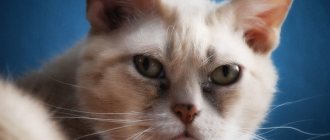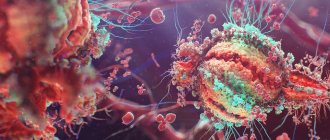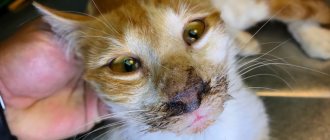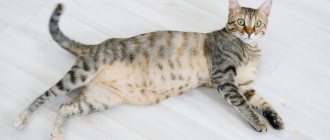The most important information for pet owners: coronavirus infection in the feline family has a strain that is different from the Covid-19 variety that is dangerous to humans. Therefore it is safe for people.
But infection of animals with “their” strain very often causes serious health problems in them, and without proper treatment can result in death. Therefore, it is important for pet owners to be able to identify the symptoms of coronavirus in a cat and know how it manifests itself.
What is coronavirus in cats?
Feline coronavirus infection owes its name to a pathogenic microbe that, under a microscope, looks like a crown, or rather a ball with spike-like protrusions. The mystery is that it constantly mutates. Biologists are still struggling with this problem, trying to understand why a non-pathogenic strain of bacteria suddenly becomes active and transforms into a highly virulent type.
Due to the unknown nature of the disease (strain), effective vaccines have not yet been created.
This is what a coronavirus molecule looks like under a microscope.
The virus includes a protein shell and nucleic acid. The main component of the virus is the genetic RNA chain - the causative agent of the disease. This virus was first recorded by veterinarians in 1966 in America. Presumably, the virus existed before, but was noticed due to increased attention to cats in nurseries.
Feline coronavirus has no geographical boundaries. It can affect not only domestic cats, but also other representatives of the cat family (pallas' cats, leopards, lynxes and others). With strong immunity, the body copes with the infection on its own, manifesting itself as a minor disorder in the gastrointestinal tract. With weakened immune defenses, the mutated coronavirus reliably takes root in the body, causing serious consequences.
If your cat suddenly gets sick, you shouldn’t give up on it. With this disease, the fatal outcome is low (does not exceed 5%). But you cannot hope for a miraculous recovery; you must immediately contact a veterinarian. Otherwise, complications are inevitable. The animal must be quarantined for at least 12 weeks. Upon completion, they are re-checked for infection.
Preventive measures
In the case of coronavirus infection, vaccination does not work. Yes, American scientists have created a vaccine that is actively used in the United States, but its effectiveness is not recognized by European veterinarians.
Thus, the introduction of a vaccine in virus carriers causes an infectious process in the most severe form of its manifestation.
A nonspecific control measure consists of proper care, proper feeding and maintenance in conditions that meet sanitary rules.
In addition, in nurseries it is necessary to do everything possible to prevent the spread of infection among animals, which can be achieved by performing simple measures:
- seropositive animals should not be allowed into the group;
- all newly arriving cats are placed in quarantine, during which (at the beginning and at the end) a blood test is carried out for the presence of antibodies to coronavirus;
- reacting cats are kept in a separate room from healthy cats;
- Wean kittens from mothers who test positive in studies at an early age, thereby ridding the group of the virus.
Until now, humanity has not created a weapon against viruses. These dangerous creatures of nature mutate every year. All living organisms are susceptible to them, from humans to primitive plants. Coronavirus in cats has now begun to change. These younger friends suffer no less than humans from viruses, which often take their lives.
Various variants of the course of the disease
Coronavirus molecules consistently kill healthy blood cells.
Upon penetration into an animal’s body, several options for the development of the disease are possible:
- Asymptomatic . The disease proceeds almost unnoticed, without obvious manifestations and does not pose a threat to the pet. The cat's behavior does not change for the worse and we can say that she is absolutely healthy. However, the carrier of the virus remains, and she is able to infect other individuals through feces. The animal may also suffer from diarrhea throughout its life.
- Light . The virus primarily affects the tonsils and intestines. The pathology develops slowly in a mild form, but over time it becomes chronic. It is often called dry. The body fights it hard and the infection usually subsides. The virus is cleared from the body within a month on average.
- Heavy . It is also called the wet form, which is considered the heaviest in flow. The virus multiplies intensively, leading to the accumulation of fluid in the peritoneum. This occurs due to the leakage of blood from damaged internal organs. Against this background, effusion peritonitis occurs, followed by ascites. If the immune system copes, remission occurs and the wet stage turns into dry. But, in both cases, the death of the animal is inevitable, since the immune cells are completely destroyed.
Mutation scheme
If a cat is a carrier of a dangerous virus, the high risk of developing FIP is only up to a year. Although protective antibodies to coronavirus are practically absent in mature cats, the likelihood of a mild type becoming severe is unlikely.
Susceptibility
The disease is recorded in young cats under two years of age, as well as in elderly cats over 11-12 years of age. Coronavirus is especially dangerous for children; their mortality rate is almost 90%, and it does not matter which strain caused the infection.
There are individuals that are immune to the virus. Why selectivity exists is unknown. Perhaps some kind of genetic protection is triggered, blocking the reproduction of the pathogen.
The incidence largely depends on the state of health, the infectiousness of the strain, and the amount of virus that has entered the body.
The pet’s immunity also matters:
- Rapidly produced antibodies will instantly capture viral cells at the time of their introduction and reproduction, as a result the clinical picture will not have time to develop at all or the disease will manifest itself in a mild form.
- With a weak immune system, the virus quickly migrates from the intestines into the body, mutating into a highly pathogenic strain with all the ensuing consequences.
As for humans, the virus is absolutely not contagious for them, so any worries about this can be safely put aside.
Types of coronavirus
There are two strains of the virus:
- intestinal (FCoV) - lead to the development of enteritis;
- highly pathogenic (FIPV, FIP) - interpretation of infectious peritonitis virus.
In the first case, the disease is tolerated by the cat relatively easily. Sometimes the owner does not even notice the pet’s ailments. Pathogens affect the mucous membrane of the small intestine, which is accompanied by diarrhea. The second option develops against the background of the first as a result of a mutation of the strain, if the animal is exposed to frequent stress and becomes hypothermic. Peritonitis of infectious origin is often fatal due to the destruction of immune macrophage cells.
Despite the identical origin of these two species, the manifestations are different. For example, a cat infected with intestinal coronavirus will not necessarily develop infectious peritonitis. Even with an acute course of the disease in an animal, there may not be a dangerous virus in its feces.
Elimination of symptoms is the main stage of treatment
Further therapy depends directly on the manifestations of coronavirus enteritis or peritonitis. If the infection provokes an increase in body temperature or surges in blood pressure, appropriate medications must be prescribed. In addition to traditional antipyretic and anti-inflammatory drugs, veterinarians can prescribe intramuscular administration of antispasmodics, for example, no-shpa. Treatment usually continues until symptoms are completely eliminated.
In case of significant dehydration and weight loss, the task of doctors is to provide additional nutrition to the body. Cats are prescribed droppers with a solution of sodium chloride and glucose, and additional vitamin complexes.
The symptomatic treatment described above, care and appropriate care for your beloved cat will give him a good chance of recovery. With infectious peritonitis, as a rule, the prognosis for animals is disappointing, but the onset of death can be delayed for some time. To do this, it is necessary to periodically pump out the accumulated fluid from the cat’s abdominal cavity.
Is it dangerous for humans?
Feline coronavirus is not transmitted to humans.
People do not have to be afraid of this infection, since the virus is viable only in the body of an animal. Human immunity is resistant to this type of microbe. Even if it gets inside, it immediately dies under the influence of protective antibodies.
Despite this, a person can become a potential carrier of the virus. We are talking about a pet being infected by its owner if the latter fails to comply with basic hygiene rules.
Transmission of the pathogen occurs through contaminated hands, rarely washed everyday objects, food (drink) plates, etc. Therefore, maintaining cleanliness is a prerequisite for keeping a mustache.
Causes of the disease
The sources of transmission of the virus are usually the cats themselves, who are sick or have already been sick and become carriers of the pathogenic virus.
Causes of defeat:
- contact with waste products left by an infected cat (licking individual parts of the body after relieving itself in an infected tray);
- nasal discharge from a virus carrier that does not stop for several months after the illness;
- eating food that a sick cat eats (if you have access to its bowl).
In rare cases, you can become infected through airborne droplets when you are near a sneezing infected animal. Coronavirus, when released into the external environment, is still infectious for a short period. However, in dry air the pathogenicity instantly disappears.
Coronavirus transmission animation
Coronavirus dies from low humidity, under the direct influence of ultraviolet radiation and disinfectants. The latter refers to the disinfection of coronavirus in cats - the owner must clean the tray daily and treat it with antibacterial drugs.
This rule applies not only to those owners who have several pets. Even one animal can infect itself several times. But even after contracting coronavirus, a cat does not necessarily become a virus carrier. Some individuals, after recovery, do not release pathogenic particles into the environment.
But stray cats absolutely carry the virus within themselves and are capable of spreading it wherever they leave their feces. And owners of mustachioed pets can bring the virus from the street into the house with their shoes. Therefore, even a completely domesticated cat is not protected from such a disease .
Spread of the virus
Ways of contracting coronavirus infection
Coronavirus is an extremely contagious disease. It is transmitted by airborne droplets. Feces are often the source of infection. Cats become infected through a shared litter box when they step in someone else's feces and then begin to lick themselves.
Pets can also become infected through a common bowl, bowl of water, or simply by licking each other. By coughing and sneezing, a cat can also infect other healthy animals.
This disease is not transmitted genetically or through mother's milk. But by licking a kitten, a sick cat may well infect the baby.
Most often, coronavirus infection appears in places where many animals are kept. Nurseries and shelters are most at risk. This is due to the fact that all animals use common trays and bowls. In such conditions, the spread of infection occurs very quickly and it is almost impossible to stop it.
Both outdoor and indoor cats can be carriers. Some of them can remain carriers throughout their lives. In this case, the owner may not suspect anything, since the animal did not have any symptoms of the disease.
We recommend the article: What could cause a swelling of the lower lip in a cat?
On surfaces, coronavirus remains viable for up to 24 hours. The lower the humidity, the shorter its lifespan. At the same time, alcohol-containing solutions and detergents can destroy the infection.
Coronavirus is sensitive to heat, but it is quite resistant to low temperatures.
Symptoms of the disease
It is difficult to accurately describe the symptoms of coronavirus infection due to its ability to manifest itself differently due to mutation. Even veterinarians often make mistakes in this regard and can make an incorrect diagnosis.
An infected cat may appear healthy in appearance
Let's consider all the possible signs of this disease, regardless of type and form:
- sudden loss of appetite;
- vomit;
- lethargy and drowsiness;
- long-lasting loose stools not related to nutrition;
- bloody or mucous discharge in stool;
- fever interspersed with chills, which is caused by fluctuations in body temperature;
- impaired coordination in movements;
- restlessness, fear of light;
- the appearance of blood vessels in the eye;
- damage to the central nervous system;
- redness of the oral mucosa;
- abdominal enlargement (indicates the development of peritonitis).
In an infected cat, the biochemical blood test is normal, and the general blood test shows an increase in the level of ESR and lymphocytes. This indicates cellular immunodeficiency.
Symptoms can occur together or separately. But even if there are several from the list, you urgently need to undergo the appropriate tests. The earlier the diagnosis is made, the easier the treatment will be.
Signs of infectious peritonitis
Complicated forms of coronavirus in an animal can be assumed based on the following signs:
- persistent vomiting;
- diarrhea with blood clots;
- elevated temperature;
- the desire to hide in a dark place;
- apathy towards everything, including food;
- yellowing of mucous membranes, ears;
- pale gums;
- cough;
- bloating of the abdominal cavity.
At the initial stage of the disease, the first disturbances are observed in the gastrointestinal tract , then the kidneys and liver fail. In the final stages, the central nervous system is affected, which is accompanied by convulsions and paresis in the animal.
Viral peritonitis (FIP) of cats. Veterinarian advice
Signs of enteritis
Coronavirus gastroenteritis manifests itself in cats as follows:
- inactivity and refusal to eat;
- intestinal disorders;
- changes in body temperature;
- strong thirst;
- mucus from the nose;
- lacrimation.
The clinical picture is so unclear that viral enteritis is often mistaken for food poisoning.
Forms of the virus
The course of the disease directly depends on the bacteria that has entered the body of the individual. They build on it when prescribing medications and therapy. There are three options for the development of malaise:
- asymptomatic;
- easy;
- heavy.
First option
considered the most common. This strain poses a threat not to the carrier, but to domestic relatives living in the neighborhood.
Mild course
typical for adults. Infection with bacteria provokes the development of enteritis. Diarrhea, high fever, runny nose, eye inflammation, and vomiting accompany the disease. The animal experiences pain in the abdomen, and a white coating forms on the tongue. Coronavirus enteritis in cats combines symptoms of poisoning and colds.
Severe leakage
associated with a sharp deterioration in condition, loss of appetite, and vomiting. Weight loss begins, mucous membranes begin to turn pale. With the wet subtype, ascites develops - accumulation of fluid in the abdomen, dysfunction of the kidneys, liver, and vascular damage. Muscle tissue gradually loses elasticity, and cramps are possible due to disturbances in the functioning of the nervous system.
The dry subtype is characterized by a sharp decrease in weight, and in later stages – a problem with the functioning of internal organs. The infection often combines both types or one begins to mutate into the other.
Wet inflammation without proper treatment lasts for about six months, then becomes dry, causing the death of the pet. Dry peritonitis is considered chronic, slowly and over a long period of time destroying the cat’s body.
Tests and diagnostics for coronavirus
If your cat is infected with coronavirus, it is important to start treatment as early as possible. And for this, it is better to play it safe and get tested, even if your pet has no visible signs of illness. After all, virus carriage can persist without clinical manifestations. This way you can protect other pets living in the house.
There is no specific test for detecting KVK infection. Diagnostics includes several stages:
- ICA/ELISA of blood or plasma . Determines the concentration of antibodies to the virus. A reduced level indicates weak immunity, when the animal’s body is not able to adequately repel pathogenic attacks, but this does not mean the absence of infection. If the virus is present, the test is positive, but where it is localized (in the tissues or intestines) is unknown.
- PCR/ICA of feces . Allows you to detect the virus in cat feces. A positive reaction indicates that the animal is infected, which requires its complete isolation from the rest - healthy ones. If the test is negative, the cat may be a carrier of the virus without releasing it into the external environment.
- Donating blood for PCR to detect coronavirus in cats . This is one of the most inaccurate methods, often showing erroneous indicators.
- Antibody titer . Makes it possible to determine the amount of antibodies in the blood serum, which shows the degree of damage. Based on the established values, the doctor can prescribe the correct treatment regimen and give an accurate prognosis of the development of events.
The simplest methods for laboratory diagnosis of infectious peritonitis are biopsy and histological examination of tissue. Only these are complex and expensive procedures that are not carried out in every veterinary clinic. It happens that to establish an accurate diagnosis you have to resort to a number of analyzes and tests.
It is possible to establish feline coronavirus only after passing more than one test
What to do if the test is positive
If the analysis shows a positive reaction, additional testing is required. It includes:
- blood biochemistry;
- titer test for the content of protein fractions in the blood;
- repeat serological analysis.
If infection with peritonitis is confirmed, the animal is prescribed a puncture from the peritoneum. This is done to examine the accumulated liquid.
This is what a test with a positive result looks like
The owner himself does not need to panic in such a situation. It is not a fact that the infection will develop into a complicated form that cannot be treated (FIP). What to do first:
- If possible, remove healthy pets from sick ones. If this does not work out, each animal has its own tray, bowl, and scoop. Toilets should be as far away from the feeding area as possible.
- Clean the trays daily and treat them with disinfectants (for example, bleach). It’s better not to add filler at all. After washing the bowls, pour boiling water over them. Change drinking water twice a day.
- Change the textiles in the room to ones that can easily be washed frequently. It is advisable to remove carpets as it will be difficult to clean them regularly. In this case, a vacuum cleaner is not the best solution, since the air flow will spread the infection.
- Install ionizing air purifiers in the room. If possible, periodically turn on UV lamps, which are good at killing germs.
- Spray a herbal infusion of chamomile and oak bark into the animal's mouth once a day. In addition to its disinfecting effect, it strengthens the mucous membrane.
- Cancel all planned events: mating, visiting exhibitions, etc.
- Transfer your pet to a special diet. Eliminate everything fatty.
- Try to exclude any acute experiences in the animal. So, for the next 2 months you cannot carry out castration (sterilization) or anything else that can cause stress.
Unfortunately, with coronavirus there is no talk of a complete recovery. When this infection is detected in an animal, the veterinarian prescribes symptomatic treatment for the animal, which allows it to locally combat pathologies that manifest themselves externally (liver dysfunction, prolonged diarrhea, ascites as a result of fluid accumulation in the abdomen). Therapy is aimed at stabilizing the pet’s general condition.
PCR tests (Polymerase chain reaction)
What to do if the test is positive
The virus can be detected in both sick and healthy cats.
Priority measures:
- Don't panic. It is not at all necessary that FIP will develop.
- Isolate other domestic cats. This is not always possible. But the owner can provide each pet with a separate tray, provide several scoops for cleaning trays, and individual bowls. The feeding area should be as far away from the toilet room as possible.
- Refuse mating, exhibitions, etc.
- Review your pet's diet. Switch to dietary nutrition.
- It is imperative to eliminate stress for 1-2 months and, if possible, not carry out activities that can cause stress - haircuts, scheduled sterilization or castration operations.
Treatment
There is no single treatment plan yet, including the antiviral drug. Carrying out therapy only with antibiotics will not give the desired results. They are included if a bacterial infection is added to a viral one. In general, coronavirus therapy is aimed at getting rid of external symptoms, stabilizing the immune system and improving the condition of the mustachioed patient.
The clinic through the eyes of a veterinarian! It is not practical to treat coronavirus in its chronic form. Drug therapy will only worsen the cat’s condition, or more precisely, it will completely damage the liver. While the virus remains in the body. Medical intervention will come in handy when the virus has mutated into FIP or progressed to gastroenteritis.
General therapy
When a coronavirus infection is detected in a cat, the two most effective drugs are usually prescribed: Roncoleukin and Polyferrin-A. If fluid accumulates in the sternum and abdominal area, it is pumped out using a puncture.
Some owners in such a situation limit their pet's drinking. This absolutely cannot be done. The animal can consume as much water as required. Excess fluid can be removed with diuretics (diuretics). In case of vomiting and diarrhea, sorbents (for example, activated carbon) and antiemetic medications are prescribed. And in order to avoid dehydration, the animal’s body is supported by drips with special compounds: blood substitutes, saline solutions and other means as prescribed by the veterinarian.
Saline solutions with glucose are prescribed to maintain the strength of a sick animal
Vitamin supplementation is required throughout the entire treatment. To do this, purchase special complexes from a veterinary pharmacy. Usually these are B vitamins and ascorbic acid. In addition, veterinarians recommend taking immunocorrectors (for example, immunoglobulin) in parallel.
As soon as the cat stops vomiting and diarrhea, feeding is restored in a special mode. After all, to counter the virus you need strength. The priority should be high-calorie food, but dietary:
- Chicken broth.
- Rice or oatmeal porridge.
- Fermented milk products.
Remove fatty foods from the diet. If the pet is on industrial food, then this partially eliminates many problems. As a rule, ready-made mixtures have a balanced and satisfying composition.
At the reception
Enteritis therapy
The mild form of coronavirus is more difficult to diagnose, but easier to treat. After the virus is detected, the animal is limited in food. The first day they give only clean water. In case of dehydration, a drip with vitamins and glucose is placed. For severe diarrhea, strengthening medications are prescribed.
On the second day, the infected patient is switched to oatmeal cooked without adding milk. From the fourth day, low-fat minced meat is gradually introduced into the diet. If all this time the animal has a stable high temperature and signs of gastrointestinal distress do not disappear, antibacterial therapy is introduced.
The treatment course ends with vitamin supplements, probiotics and prebiotics, designed to restore the intestinal microflora.
Treatment of peritonitis
Peritonitis is much more difficult to treat, although this form is rare in cats. Veterinarians have developed a unified scheme:
- Relieving pain . To do this, apply a cold compress to the stomach and give painkillers.
- Symptomatic therapy . The doctor prescribes the same medications as for gastroenteritis. To facilitate breathing, the animal undergoes a puncture of the abdomen to remove the accumulated fluid. True, such a measure is temporary.
- Stabilization of the gastrointestinal tract and boosting immunity . Colon cleansing is performed using enteral lavage with saline solution. The immune system is strengthened by taking vitamin and mineral complexes.
Antibacterial drugs
List of antibacterial agents for coronavirus therapy:
- Tylosin;
- Amoxiclav;
- Levomycetin;
- Penicillin.
Prev
Next
Diuretics for coronavirus
List of commonly prescribed diuretics:
- Kotervin;
- Lasix-Neo;
- Urotropin;
- Indapamide;
- Furosemide.
Prev
Next
Immunomodulators
Means for correcting immunity:
- Immunoglobulin;
- Maxidin;
- Fosprenil;
- Gamavit.
Prev
Next
To strengthen the immune system, you can use folk remedies - infusion of nettle and rosehip.
Immunostimulants are recommended in the form of cat vaccinations. Then the effect will be better. In addition, when taken orally, the intestinal mucosa does not accept the medicine well.
Probiotics
Antibacterial intervention during treatment not only destroys the pathogenic environment, but also negatively affects the beneficial intestinal microflora of the animal. Therefore, upon completion of treatment it is required to restore it. Probiotics are used for this:
- Fortiflora;
- Zoonorm;
- Subtilis;
- Enterol and others.
The duration of the appointment is determined by the doctor.
Specialist additions! Typically, probiotics are prescribed to be taken in parallel with an antibacterial course. Sometimes they are canceled, but lactobacilli are prescribed instead. This is due to the fact that the intestinal microflora suffers the most. Just don’t self-medicate in this regard and overdo it with probiotics. This can lead to addiction, which can lead to more serious problems.
Prev
Next
Possible complications
Feline coronavirus is dangerous because it can transform into FIP at any time. The main factor provoking the development of this incurable disease is natural origin. So, cats of the following breeds are more susceptible to this:
- Abyssinians;
- British Shorthair;
- Australian smoky;
- Bengals;
- Burmese;
- rexes;
- Scottish folds.
The most risky age for the clinical manifestation of FIP is before one year and after 10 years . Severe stress in an animal can stimulate the development of the disease.
Clinical picture
The appearance of certain symptoms, as already noted, depends on the degree of virulence of the pathogen.
If we talk about viral enteritis, then it is characterized by:
- Signs of intestinal dysfunction: diarrhea, slight loss of appetite, rarely vomiting, which go away on their own over time.
- Sometimes cold-like symptoms such as watery eyes and runny nose may occur.
Prolonged diarrhea leads to an increase in the pathogenic properties of the virus and the transition of the intestinal form of infection into a systemic disease.
Infectious peritonitis caused by coronavirus does not have any specific and pronounced symptoms at the beginning of the process. Fatigue, apathy, decreased appetite, vomiting and diarrhea may occur.
Over time, the clinical picture acquires the characteristic features of viremia:
- the cat’s depressive state increases;
- weight loss;
- mucous membranes turn pale, which indicates anemia;
- ascites appears.
As the amount of virus in the body increases, the functioning of the kidneys and liver is disrupted, and symptoms of damage to the nervous system appear (convulsions, muscle atony, etc.).
Do kittens get sick and how are they treated?
Kittens also suffer from coronavirus.
Coronavirus infection is not very selective in terms of choosing the target of infection. Any animal, regardless of breed and age, can get it. Scientists are still puzzled as to why some organisms are more resilient. But based on veterinary practice, the most vulnerable groups of cats can be identified: albinos, elderly males and kittens.
Despite the inability to become infected in the womb, a month after birth a cat can become infected with coronavirus. Typically, symptoms clearly manifest themselves when the baby is separated from the mother cat. Kittens up to one and a half years old have a weakened immune system, so in the event of a viral infection, the body is unable to resist the pathogen. Immune protection stabilizes in cats by the age of two.
If a kitten is infected, treatment will be the same as for an adult cat. The only thing is that age restrictions are taken into account when taking a number of drugs. Therefore, it is not recommended to give any medications on your own.
Coronavirus vaccines
Scientists are still trying to develop an effective, and most importantly, safe vaccine. Currently, the intranasal vaccine from Pfizer, Primucell, is actively used. It is created on the basis of a temperature-dependent strain of coronavirus (reproduces exclusively at low temperatures in the oral cavity). Thanks to this, local protection is developed at the site where the pathogen enters the body, but a sufficient amount of antibodies is not synthesized.
Vaccination with this drug is relevant against FCoV. But in the case of infectious peritonitis, the effectiveness of the vaccination is not guaranteed. Although, when infected with the virus, the animal will experience a milder form of the disease.
Veterinarians advise vaccinating cats before they reach 16-17 weeks. But often babies have already become infected by this point. To get vaccinated, a doctor is called to your home to avoid contact of the infected pet with healthy people. After the procedure, you cannot let the cat go outside or attend exhibition shows for at least 3-4 days.
Vaccine for prevention
Animals staying in nurseries are at greatest risk - there the virus can be more actively transmitted due to overcrowding. Therefore, before taking a baby from there, you need to find out from the breeder about cases of coronavirus disease in this community.
Caring for a sick animal
Caring for a sick cat means, first of all, following all the recommendations of the attending physician. All medications must be given strictly according to established recommendations. If your health worsens, you must return for a second appointment to adjust your treatment.
When used in the treatment of GS-441524, ongoing monitoring of blood tests and abdominal ultrasound will be required to ensure the effectiveness of treatment. These studies should not be neglected.
Disease prevention
Coronavirus infection is one of the most common serious diseases among domestic cats; dogs tolerate it much more easily. Scientists even compare this disease with blood leukemia (leukemia). Therefore, it is easier to prevent damage than to look for treatment methods later.
Veterinarians recommend following basic measures:
- Create decent living conditions for your pet . The room should be dry, clean, and warm. The animal's resting bed, food and drinking bowls, litter tray, and other household items are regularly washed and disinfected. It should be noted that the pathogenic microbe dies at high temperatures, under the influence of ammonia and sodium hypochlorite.
- Organize a balanced and nutritious diet . Be sure to include vitamin and mineral supplements in the diet if the cat is on natural food (ready-made food already contains them).
- Strengthen the animal's immunity in every possible way . To do this, they periodically visit a veterinary clinic for examination and obtain medical prescriptions. Take your pet out into the fresh air more often. You can plant a special herb on the windowsill, which is useful not only for the immune status, but also for health in general. Any diseases are treated without delay to avoid complications.
- Before adoption, the kitten is placed in a two-week quarantine (isolated) . This is provided that there are other pets in the house. It is also unacceptable for a domestic cat to come into contact with stray animals while walking.
- Follow a deworming schedule and treat for fleas . It is advisable to carry out antihelminthic treatment once every 3 months. These parasites greatly weaken your pet's immune system, thereby putting it at risk of contracting the coronavirus.
The owner should try to avoid frequent stressful situations for his pet. This means: moving to another place, transferring the animal into other hands, traveling together, etc. This has a detrimental effect on the immune system.
To be on the safe side, it is recommended to get a vaccine, but it does not provide a 100% guarantee of safety against coronavirus infection. Breeding cats and female cats should be tested for the virus twice a year. Tests are required before each mating. Seronegative and seropositive individuals cannot be mated, otherwise infection is inevitable.
Popular questions and answers
Conscientious and caring owners are always concerned about the condition of their pet. This is especially true for possible diseases. But the coronavirus is a separate topic, about which many questions arise. The main ones are answered by specialists.
Is coronavirus transmitted from cats to dogs?
Cats cannot transmit coronavirus to dogs, and vice versa, due to their different physiologies. It is worth noting that a dog vaccine will be useless for cats if they are infected with the virus. In scientific terms, the virus has different genesis.
Here, for comparison, we can cite a human virus from China. They have the same name, but it affects a single living organism differently. The same goes for human and feline AIDS.
Statements from a veterinarian! Dogs also have their own coronavirus, similar to that of cats. It manifests itself in the form of symptoms, as in gastroenterocolitis and respiratory lesions. However, the virus does not mutate into a complicated form of FIP.
Can it be treated at home?
As such, the measures that an owner can take against coronavirus infection in an affected pet can hardly be called a full-fledged treatment. The main thing is to protect the animal from nervous overexcitation, which greatly weakens the immune system and aggravates the situation.
Therefore, it is necessary to provide the cat with comfortable living conditions and strengthen the body’s protective properties with the help of vitamins and minerals in the form of special supplements. If there are gastrointestinal disorders and concomitant infections in an animal, try to cure them as quickly as possible. Here you need to focus on test results and doctor’s orders.
Veterinarians say that it is not the virus itself that should be feared, but its mutation. In most cases, this is what leads to the inevitable death of the cat. A person does not have the opportunity to somehow prevent or influence the process of mutation of a microbe. This phenomenon depends on the immune status of the animal and the severity of the lesion.
Kittens aged six months to one year are resistant to coronavirus. From a large litter, usually only one baby can get coronavirus peritonitis. It is easy to become infected directly with coronavirus, but peritonitis is almost impossible (it is not contagious). Only the intestinal form of infection – gastroenteritis – can be transmitted.
Is coronavirus transmitted from cats to humans?
Veterinarians have noted this trend today - there have been many requests to euthanize their mustachioed pets due to their coronavirus infection. Many compare it to Covid-19 and are afraid of getting infected. Only these are completely different diseases.
Feline coronavirus is a certain strain of pathogenic bacteria, similar in type to the causative agent of human herpes. Only the herpes virus is present in almost everyone. The situation is similar with the cat - it is in the natural nature of the physiology of cats. Under severe stress or having been ill with something, the cat’s immunity is weakened. Against this background, the virus mutates and it dies. But most animals live quietly with this pathogen, which is in a “dormant state.” And they are not dangerous to people.
Even by kissing your pet, infection will not occur. Only with constant contact with an infected cat (if it is a stranger) can you bring the pathogen into your own home and infect your cat. Therefore, if your pet is diagnosed with coronavirus, you should not immediately abandon it.
How is coronavirus transmitted in cats?
Cats usually become infected with coronavirus enteritis through their own feces. It is rare that the virus is transmitted through saliva or airborne droplets. And the FIPV form is generally viable only in blood cells, and therefore is not excreted through feces and saliva.
It is impossible to become infected with infectious peritonitis that develops against the background of coronavirus. It is a consequence of gastroenteritis - a mutation of the pathogenic strain.
Do cats get sick with covid 19 coronavirus?
Antibodies to different types of coronavirus are present in most cats and dogs. But all forms are in no way related to the human disease called Covid-19. So cats don't get sick from it.
Can a cat get coronavirus from a person?
Those sick with the Covid-19 coronavirus are advised not to have close contact with pets, as there is a possibility of transmitting the virus. Although in reality only one such case was recorded. This happened in Belgium, where the owner infected his cat.
Therefore, you should entrust the care of your pet to someone close to you. If this is not possible, then wear a protective mask and follow basic hygiene rules (wash your hands often, do not kiss an animal or allow yourself to be licked by it, do not give food from your hands).
Characteristic features of the disease
This virus is from the Coronaviriadea family. All cat breeds are susceptible and susceptible. Vaccination can prevent symptoms of infection
.
This will be the best option if the animal walks on the street and communicates with street cats. Coronavirus in cats affects the abdominal organs
.
The disease is characterized by the appearance of complications. Cases of death
cannot be excluded .
The virus has a peculiar shape, which is why it got its name. It can be detected by microscopy. Its shell has projections similar to a halo or crown. This virus is dangerous because it causes two types of disease . There are: feline infectious peritonitis and coronavirus enteritis. Moreover, the first one cannot be cured. These strains belong to the same family. They are not dangerous for humans
. Children, elderly people, and family members with weakened immune systems will not become infected from a pet.
Once in a cat's body, the virus can mutate.
, turn into a virulent strain causing peritonitis.
Dogs also suffer from this disease
. Science does not know what reasons prompt the pathogen to change. Its mutations occur spontaneously. Many scientists tend to assume that the main factor is genetic predisposition and stressful situations. The idea that enteritis progresses to fatal peritonitis has not been proven and is unlikely. Probable reasons for this transition:
Supporters of the classical theory believe that mutations can occur in some exceptional cases. They give a special role to age, the physiological state of the body, living conditions, and genetics. This theory has a right to exist, since there are occasional cases of degeneration of the virus.
Other researchers in the field believe that strains of the virus that are prone to mutation are present in the environment and circulating freely. This may be why uncontrolled outbreaks of the disease occur. Individuals living in nurseries and shelters are susceptible, where a significant proportion of animals become ill. A theory does not have facts to support the truth of the opinion. Scientists are working on this issue.
Clinic of the disease
The disease is especially severe in fragile kittens.
.
Their immune system is not fully developed and cannot cope with the virus. Cases of death in kittens are not uncommon
.
The virus multiplies in the small intestine and has a pathogenic effect. The small animal begins to vomit. Then diarrhea. The body quickly becomes dehydrated. This happens in a few hours. Intestinal upset may occur over 2-4 days
. The process ends either with the death of the animal or with recovery. After an illness, the virus does not disappear completely. The animal will be the carrier. This means that the cat will not get sick, but it may well infect its brothers who have not been ill.
Factors contributing to the development of the disease
All breeds without exception are at risk. This is not affected by age and gender. It is worth especially noting the fact that about 4% of the entire population of domestic cats do not get sick due to innate resistance to coronavirus. Scientists have found that this resistant feature is not inherited by offspring. For what reasons some individuals are not susceptible to the disease remains unknown.
We can only say with some certainty that certain categories of animals get sick more often:
1 Males up to two weeks old;
2 Adult cats over 10 years old;
3 Animals after illness, whose body is exhausted and weakened;
4 Worm infestations make the animal’s body even weaker and more vulnerable to infection.
Can coronavirus be transmitted from one cat to another?
usually occurs through food and water
.
Unsanitary conditions
, lack of proper care, and dirt in the room contribute to the spread of viral infection.
The virus feels comfortable in such conditions. There are cases of infection by airborne droplets
, but this is how dogs become infected. After a week after the virus has been introduced into the animal’s body, the first signs of the disease appear. If these are small kittens, old cats or weakened for some reason, then the disease can manifest itself in the first days.
It has been noticed that a tray with cat litter is a convenient place for the development of the virus. There it can maintain its viability for quite a long time. To avoid mass infection and the spread of viral infection, it is better to burn the litter with animal excrement. You can pack it in a plastic bag, tie it tightly and throw it away. This infection becomes focal in shelters and large gatherings of animals.
. They are kept in cramped, uncomfortable conditions. The cages are rarely cleaned. Animals are in close contact. The presence of feces promotes rapid infection and spread of the disease. Many animals are potentially dangerous to other individuals. The infection can go beyond the nursery, quickly spread, and cover large areas.
Symptoms and treatment
The virus is localized in the gastrointestinal tract
and causes harm in the process of its life activity. When it enters the body, it begins to move through the digestive organs and, upon reaching the small intestine, begins its activity. The glandular epithelium of the gastrointestinal tract is especially affected. Viruses undergo the process of replication, that is, doubling DNA. Thus, he creates many similar copies of himself. As a result of the virus multiplying, the host cells die. In the case of the enteritis virus, no special symptoms of the disease are observed. The cat shows no signs of illness. This is due to the fact that the replication of the virus is not so intense that cellular decay is obvious. A different picture is observed when the causative agent of viral peritonitis enters.
1. Minor diarrhea appears. A runny nose may appear, the cat becomes lethargic, there is a decrease in appetite, and it drinks water in the usual amount.
2. Rare cases of vomiting are recorded. Vomiting and diarrhea are short-lived. They disappear on their own.
3. Lacrimation occurs. The gag reflex and diarrhea become frequent and occur constantly.
4. The animal practically does not eat. Starts to drink more fluids. Fatigue sets in quickly.
5. You may notice a change in the color of the stool. They become greenish-brown, watery with an unpleasant odor. Initially, there is no blood in the stool, but as the disease progresses and develops, the presence of blood is noticeable.
6. The body quickly loses water, dehydration occurs. This is evidenced by the appearance of additional symptoms: dry skin, loss of elasticity, the coat becomes dry and brittle.
7. If death does not occur, changes appear in the central nervous system. This is expressed in neurological seizures.
8. The peak of the disease is coming. The intestinal microflora extends beyond its boundaries and spreads into internal tissues. This is confirmed by the formation of erosions and ulcerations. If left untreated, perforation (an opening to the intestine) appears. Often, therapeutic measures remain futile.
Any type of virus is difficult to detect. Difficult to diagnose. There is no method for identifying and making an accurate diagnosis. An accurate diagnosis is made based on the results of a histological examination of the animal’s tissues in the event of its death.
The clinical sign characteristic of coronavirus disease in cats is profuse diarrhea . But this is not enough information. Serological methods for examining feces also do not provide reliable results. The PCR reaction can be false positive or false negative. This may be due to the presence of coronavirus in the cat's body. However, an animal may not get sick, but be a carrier of it. What symptoms should you pay attention to and consult a veterinarian? The animal's body temperature rises sharply. Infectious peritonitis manifests itself as effusion in the chest and abdominal cavities. Characterized by the development of uveitis. These symptoms are not the main ones, and it is not possible to make a definitive diagnosis.
If your pet has any abnormalities, you should immediately contact a veterinary center
. In the laboratory, after taking blood from a vein, a study will be carried out: general analysis and biochemical analysis. A very important indicator will be protein fractions, that is, the percentage of albumin and globulin. These indicators decrease sharply during coronavirus infection.
Can coronavirus in cats be cured in adult animals?
Timely contacting a veterinary center plays an important role.
.
In the early stages immunomodulators , Interferon, Ribaverin, and antibiotics are prescribed. These drugs relieve symptoms and slow down the replication of the virus. Allows the body to fight infection. Unfortunately, they do not cure the disease. If vomiting and diarrhea occur, then replace the fluid loss with saline systems .
Temperature and pressure are measured. Initial changes in the cat’s well-being should alert you. You need to call a veterinarian to your home to “catch” the disease and begin treatment and monitoring of the animal. It is better to prevent a disease than to treat it, so you need to vaccinate your cat in advance. If the animal is sick, then symptomatic treatment and care can prolong the pet's life.
conclusions
Feline coronavirus is a serious disease of infectious origin, which most often affects kittens under 2 years of age and adult cats that have crossed the ten-year age mark. The virus causes gastroenteritis, which can, under certain circumstances, develop into a chronic form. With weakened immunity and other negative factors, the strain mutates and leads to even more harmful consequences. If the disease can be diagnosed in the early stages, the process can be stopped with medication. Otherwise, the treatment is not effective and the animal dies.
Be healthy!
Who's at risk
High susceptibility from 3 months to 3 years. Coronavirus infection is rarely diagnosed in older cats. Sometimes a chronic form of FECV is detected.
The disease spreads quickly in crowded conditions. The probability of infection of individuals in a small area when a coronavirus hits is from 70 to 100%. When the intestinal form of the pathogen mutates into a viral one, a massive outbreak of the disease occurs, threatening the lives of almost all cats.
FECV infection occurs due to poor hygiene and disinfection of rooms and cells. When the intestinal form mutates and the pathogen begins to multiply in macrophages, viral peritonitis develops.










